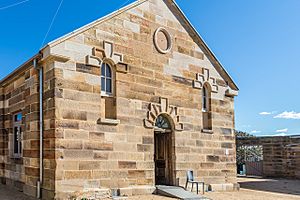Cockatoo Island Mess Hall facts for kids
Quick facts for kids Mess Hall |
|
|---|---|
 |
|
| Location | Cockatoo Island, New South Wales, Australia |
| Official name: Mess Hall (former) | |
| Type | Listed place (Historic) |
| Designated | 22 June 2004 |
| Reference no. | 105259 |
| Lua error in Module:Location_map at line 420: attempt to index field 'wikibase' (a nil value). | |
The Mess Hall is a really old and important building on Cockatoo Island in New South Wales, Australia. It's part of a special area called the Prison Barracks Precinct. This building is so important that it's listed on the Australian Commonwealth Heritage List, which means it's protected because of its history and unique features. It was added to this list on June 22, 2004.
Contents
Discovering the Mess Hall's Past
Cockatoo Island's Early Days
Cockatoo Island became a prison in 1839. This happened because the Governor of New South Wales, George Gipps, decided to send prisoners there. The first prison buildings were ready by October 1841. One of the first jobs for the prisoners was digging huge holes to store grain.
Later, a big dry dock called the Fitzroy Dock was built on the island. This dock was finished in 1857 and was used to fix Royal Navy ships. Cockatoo Island soon became the main government shipyard in Australia.
From Prison to School and Back
In 1869, the prisoners were moved off the island. The prison buildings then became a school for girls and a place for young people needing guidance, starting in 1871. The shipyard area was separated from the school by a fence.
After the girls left in 1888, prisoners were sent back to the island. The prison continued to operate until about 1909. Meanwhile, the shipyard grew even bigger, and another large dock, the Sutherland Dock, was built in 1890. The New South Wales Public Works Department officially named Cockatoo the state dockyard.
The Island's Role in World Wars
In 1913, Cockatoo Island became the Commonwealth Dockyard. The island played a huge role during the First World War by building and repairing ships for the Royal Australian Navy. The old prison buildings, including the Mess Hall, were used as offices during this time.
From 1933, a company called Cockatoo Docks and Engineering Co Ltd leased the dockyard. The island was incredibly important during the Second World War. After the war, the dockyard continued to operate, even adding facilities for submarines. The dockyard finally closed in 1992. Today, the island is managed by the Sydney Harbour Federation Trust.
Building the Mess Hall
The Mess Hall itself was built between 1847 and 1851. It was designed by Gother Kerr Mann, who was the engineer on the island. The Mess Hall was built to the west of the main prison barracks. It helped complete the enclosed area of the prison precinct with its walls.
Over time, the Mess Hall was changed to be used as offices. Its windows were made larger. However, the building is still mostly in its original condition. The Mess Hall and other buildings from the prison era are very special. They are the only remaining large group of prison buildings in New South Wales that were paid for by the British government. They are also one of the most complete sets of old prison structures in Australia.
What the Mess Hall Looks Like
The Mess Hall is a beautiful building made of sandstone. It used to stand by itself. Its fine gable (the triangular part of the wall at the end of a pitched roof) and east end make it stand out in the area.
On the ground floor, the windows are square. On the upper floor, there's a simple verandah with wooden posts. Above the verandah, there are two attic windows with rounded tops. The roof has a pointed shape and is covered with corrugated iron. The building's style is called Old Colonial/Victorian Georgian.
How Good is its Condition?
In 1997, a plan was made to help look after the building. It noted that the roof of the main hall might need to be replaced. Some repairs had been done inside, but more work was needed. Also, the metal rods that help support the roof might need to be tightened.
As of May 2001, the Mess Hall was still mostly in its original form. The sandstone walls were in good condition, and the inside of the building was generally satisfactory.
Why the Mess Hall is Important
The Mess Hall was added to the Australian Commonwealth Heritage List on June 22, 2004, because it meets several important criteria:
A Glimpse into History
The Mess Hall, finished around 1847-1851, is very important because it shows us what early prison management was like in Australia. It also tells the story of Cockatoo Island's other uses, like being a school for girls and a major shipyard.
A Rare Find
This building is part of a special group of prison buildings. It's the only remaining large set of government-funded prison structures in New South Wales. It's also one of the most complete collections of old prison buildings in all of Australia.
A Classic Example of Design
The Mess Hall is a great example of the Colonial/Victorian Georgian style of prison building from that time period. Its design shows how buildings were made back then.
Beautiful and Eye-Catching
With its detailed design and striking gabled roof, the Mess Hall is architecturally significant. It adds a lot to the beauty and look of the entire precinct.
A Showcase of Building Skills
The Mess Hall's fine details and impressive gabled design also show off the architectural skills of the time. It's a testament to how buildings were constructed back then.

